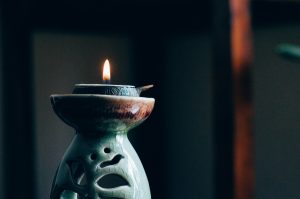
A candle flame is often the choice for tratak
Tratak is the practice of steadily gazing on one point. In our yoga classes in Kreuzberg, we practice Tratak on a candle flame, but virtually anything can be used as the object of concentration.
The term tratak from Sanskrit means means “to look” or “to gaze”.
It is one of six Hatha Yoga methods to remove toxins and sluggishness from the body’s organs. This practice is said to relieve eye ailments, making the eyes clear and bright. It also said to improve a whole range of physiological and mental functions. Used in the treatment of insomnia, depression and anxiety, Tratak can improve the memory and concentration.
Through this practice, you learn that concentration involves no strain or effort, but that it is a relaxed state in which your attention remains easily fixed on an inner or outer object of your choice.
Here is a quick guide from this Yogapedia article:
- Light a candle and sit at least one meter away from it with the flame at eye level.
- Focus the gaze on the flame and keep it there without blinking for as long as possible.
- As thoughts arise, acknowledge them then return to focus on the flame.
- When the eyes start to water and tears flow, close the eyes and focus on the after-glow of the flame, bringing awareness to the third eye point.
- Meditate here until ready to come out of the practice.
We offer Hatha Yoga classes with Pinelopi and Vinyasa yoga with Juli. Our yoga Kreuzberg Berlin classes are open for and welcoming to beginners. We also offer Berlin business yoga, pregnancy yoga, and private yoga classes, including for people struggling with chronic pain.







